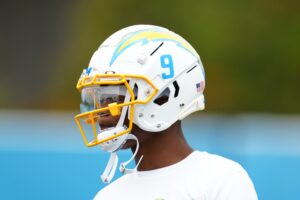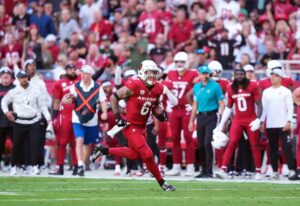With a 2-1 record, the New Orleans Saints are off to their best start since the 2013 season. However, they have already allowed over 1,000 yards and 10 touchdowns through the air in the process.
The Saints late-game resilience against the Cleveland Browns and Atlanta Falcons is a big reason why they’ve achieved a winning record despite frequent coverage errors, but it’s also because they’re thriving elsewhere.
New Orleans won’t have a winning record for long unless they improve their pass defense, but their performances in other areas provide hope for this team.
New Orleans Saints Pass Defense Holding Back an Otherwise Impressive Team
Offense on Historical Pace
At age 39, quarterback Drew Brees is having his best season. Through three games, Brees has averaged 359.3 passing yards per game while completing 80.6 percent of his passes. He’s thrown eight touchdown passes, zero interceptions, and generated a 122.2 passer rating.
Brees probably won’t finish the season at this pace, but if he did, he’d set new NFL records with 554 completions and 5,748 passing yards, and break his own single-season completion percentage record of 72.6 percent set last season. However, New Orleans would probably prefer it if Brees didn’t have to put up such numbers to keep them in games.
Wide receiver Michael Thomas has been the driving force of the Saints success through the air. He’s caught 38 passes on 40 targets for 398 yards and three touchdowns. At his current pace, not only would Thomas shatter the current single-season catch record with 202 receptions, but he would also gain a record-breaking 2,122 receiving yards.
It’s impossible to continue feeding Thomas this much with such a high success rate, or for the Saints to rely so much on the pass. Fortunately, their run game is coming together after generating just 43 yards in the season opener.
Against Atlanta, running back Alvin Kamara gained 66 yards on 16 carries and New Orleans totaled 143 total rushing yards largely due to gadget plays involving Ted Ginn and Taysom Hill. New Orleans only has to survive with this all hands on deck rushing approach for one more week as Mark Ingram finishes his four-game suspension. It shouldn’t take too long for the run game to thrive again after his return.
Some Things Actually Are Working on Defense
Although New Orleans has routinely hemorrhaged yards through the air, they’ve been quietly strong against the run. They’ve allowed 84.3 rushing yards per game, the sixth-lowest figure in the NFL while limiting opponents to a league-best 3.0 yards per carry average. Opponents have gained only 10 first downs on the ground, and 13 rushing attempts against New Orleans have lost yardage.
So far this is a dramatic improvement for a defense that yielded 111.7 yards per game and 4.4 yards per carry last season. It’s also created longer third down situations for opponents, helping New Orleans improve in that area as well. While the Saints did allow Tampa Bay to convert on eight of 13 third-down attempts in week one, they’ve since allowed just eight more conversions on 23 attempts.
While these strong points are encouraging, they’ve done little to alter the overall performance of the Saints defense. New Orleans still ranks 30th in yards allowed and 32nd in points allowed. The easy solution for opponents struggling to run against New Orleans has been to throw the ball downfield, which are low-percentage pass attempts against most defenses. Unfortunately, there’s no reason to think this will change anytime soon.
Little Hope in Sight for Coverage Woes
New Orleans ranks last league-wide in each of the following pass defense categories: touchdowns (10), touchdown percentage (10.8 percent), yards per attempt (11.2), and passer rating (141.7). They are on pace to break some of their unwanted records set in recent years, such as their 45 touchdown passes allowed in 2015.
It’s difficult to pinpoint how this happened since the Saints brought back a largely successful 2017 defensive backfield and added veterans Kurt Coleman and Patrick Robinson. Cornerback Ken Crawley was the biggest culprit in weeks one and two, but benching him in favor of P.J. Williams against Atlanta spawned even worse results.
If things weren’t bad enough, Robinson reportedly suffered a high-ankle sprain on Sunday. Now New Orleans will have to lean on both Crawley and Williams with little depth behind them. Cornerback and special teams contributor Arthur Maulet was cut last week to open a roster spot, and on Monday the Indianapolis Colts claimed his contract.
Maulet had a strong training camp, beating rookie draft picks Natrell Jamerson and Kamrin Moore for the initial roster. If Maulet was truly worth keeping over either pick, New Orleans could sure use him now. The only other cornerback on the roster aside from Marshon Lattimore is Justin Hardee, another special teams contributor with little experience on defense.
New Orleans is bringing in Sterling Moore for a visit this week as a potential stop-gap. Moore isn’t the most athletic corner, but he proved to be reliable for the Saints in 2016 and 2017. There’s little chance he’ll drastically change their fortunes at this point though considering he failed to make an NFL roster this year.
The Saints could try a more schematic solution for their pass defense. Perhaps they’ve been putting too much pressure on young safety Marcus Williams, leaving him alone frequently in single-high zones. Going with more two-deep safety looks could help New Orleans cut down on the long passes.
On the other hand, maybe the Saints should call more blitzes in an attempt to accelerate a pass rush with six sacks in the last two games and give opposing quarterbacks less time to find deep targets.
Overall, this Saints team has a better chance to overcome their coverage issues than their 2012, and 2014-2016 counterparts. The 2018 Saints boast more overall talent, a more balanced offense, and a better run defense. However, they could still slide back into the same mediocrity of those teams unless some small improvement is made against the pass.






